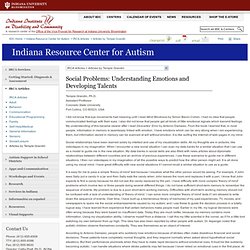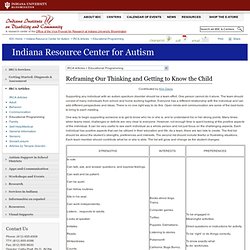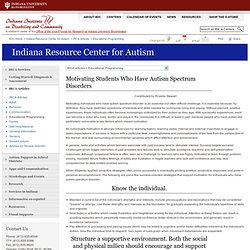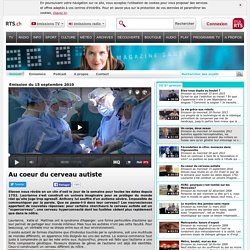

Social Problems: Understanding Emotions and Developing Talents. Temple Grandin, Ph.D.Assistant Professor Colorado State UniversityFort Collins, CO 80523, USA I did not know that eye movements had meaning until I read Mind Blindness by Simon Baron-Cohen.

I had no idea that people communicated feelings with their eyes. I also did not know that people get all kinds of little emotional signals which transmit feelings. My understanding of this became clearer after I read Descartes’ Error by Antonio Damasio. From the book I learned that, in most people, information in memory is seamlessly linked with emotion. Social relationships have been learned solely by intellect and use of my visualization skills. It is easy for me to pass a simple 'theory of mind' test because I visualize what the other person would be seeing. Communicative Functions or Purposes of Communication. Contributed by Beverly Vicker, CCC-SLP There are many different classification systems available for looking at the purposeful uses of communication.

Models are primarily of interest to researchers and professionals within the field of speech language pathology. This article, however, is a hybrid listing of aspects of communication that are especially important to assess and track with children/students with an autism spectrum disorder (ASD). The article is designed to give a basic orientation to people outside of the speech pathology profession because these are the people who will spend more time with the child than the speech pathologist.
Awareness of what to observe can contribute volumes to the development and implementation of a program for a child with ASD. Intentionality Before looking at types or purposes of messages from the child, it will be important to observe and understand about how intentional the child’s daily communication is. AAC Website Resource List. Restricted Repertoires in Autism and What We Can Do About It.
Reframing Our Thinking and Getting to Know the Child. Contributed by Kim Davis Supporting any individual with an autism spectrum disorder should be a team effort.

One person cannot do it alone. The team should consist of many individuals from school and home working together. Everyone has a different relationship with the individual and can add different perspectives and ideas. There is no one right way to do this. One way to begin supporting someone is to get to know who he or she is, and to understand his or her strong points. These lists can provide guidance in how to engage the student in academic activities. Look at the day to see what the balance may be between the two lists.
There are two additional lists that would be useful for the team to create in order to get a more complete picture of the student. Once you have completed the first four lists, it is time to use that information to create learning situations for the student. Motivating Students Who Have Autism Spectrum Disorders. Contributed by Rozella Stewart Motivating individuals who have autism spectrum disorder is an essential but often difficult challenge.

It is essential because, by definition, they have restricted repertoires of interests and skills needed for community living and coping. Without planned, positive experiences, these individuals often become increasingly victimized by their autism as they age.
Get Engaged: Designing Instructional Activities to Help Students Stay On-Task. Contributed by Kara Hume The amount of time a student with an autism spectrum disorder (ASD) is actively attending to and interacting with his/her environment has been cited as one of the best predictors of positive student outcomes (Iovannone, Dunlap, Huber, & Kincaid, 2003).

When a student is engaged it is more likely that connections are being formed, productive routines are being created, and interactions are occurring. When unengaged, students lose out on important learning opportunities and may become distracted, disruptive, or may demonstrate challenging behaviors. When these challenging behaviors occur, it is important that elements in the environment are examined—including variables related to the curriculum.
Curricular variables may include the length of the instructional activity, the difficulty of the content, the types of materials, the organization of the task, and/or the relevance of the information presented (Dunlap, Kern, & Worcester, 2001). Au coeur du cerveau autiste - rts.ch - émissions - 36.9° Steven nous révèle en un clin d'oeil le jour de la semaine pour toutes les dates depuis 1752.

Laurianne s'est construit un univers imaginaire pour se protéger du monde réel qu'elle juge trop agressif. Anthony lui souffre d'un autisme sévère. Impossible de communiquer par la parole. Que se passe-t-il dans leur cerveau? Les neurosciences apportent de nouvelles réponses: pour certains chercheurs le cerveau autiste est un "supercerveau", une cerveau hyperconnecté dont les fusibles cèdent plus rapidement que dans le nôtre.
Laurianne, Katia et Matthias ont le syndrome d'Asperger: une forme particulière d’autisme qui leur permet de partager leur monde intérieur. Il existe autant de formes d’autisme que d’individus touchés par le syndrome, soit une multitude de mondes différents, en apparence très éloignés les uns des autres. Les enfants autistes n'ont souvent pas conscience du danger. Cette nouvelle vision de l’autisme a une première conséquence: elle bouleverse le dépistage. Justine Florence - ACCUEIL. Autisme Information Science. Facilitating the iterative design of informatics tools to advance the science of autism.